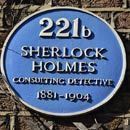4 Fictional Works People Insist Are Real

People love stories. Movies and books let us escape our own horrible lives for a few hours. Some people love stories a little too much, however, and eventually begin to forget (or even deny) that they are fictional. For example ...
221B Baker Street

When Sherlock Holmes isn't faking a British accent with Jude Law in between Iron Man sequels, he hangs out at 221B Baker Street. The address is such a fixture in popular culture that people regularly mail letters to it, although Sherlock Holmes doesn't deliver presents, so the purpose of these letters is unclear. However, while Baker Street does exist, there has never been a 221B.

When the Abbey National Building Society bought the flats at Baker Street, they got so much of Sherlock's mail that they hired a full-time secretary to answer it (presumably Greg Kinnear from Dear God). Ultimately the museum was granted special permission to create the address 221B, but it will take another 100 years of unsolicited mail before they're allowed to create Sherlock Holmes, because he totally isn't real either.
The Texas Chainsaw Massacre

In 1974, director Tobe Hooper created a happy-go-lucky clan of cannibal murderers based on real-life maniac Ed Gein for his film The Texas Chainsaw Massacre. Because the movie's posters read "Based on a True Story," most people decided that meant that the film was a historical dramatization, if not a straight-up documentary.
Gunnar Hansen, the actor who played Leatherface, is so often asked about the "true story" that he addresses it on his website, even mentioning occasions where he meets people who insist that they remember when the "real" Texas Chainsaw Massacre happened, which is sort of like telling Tom Hanks you remember when he played ping pong in the Olympics.
The Texas Prison Museum, not wanting to be left out of the "bizarre things that have a website" club, also has an article on its homepage debunking the myth that Leatherface was ever a prisoner there, or indeed was ever a person who existed. And Snopes, the arbiter of urban legends, has an entire page detailing that never at any point in history did the titular massacre actually occur.
National Geographic Photographer Robert Kincaid (from The Bridges of Madison County)
The Bridges of Madison County is about a National Geographic photographer named Robert Kincaid who goes to Iowa to take pictures of bridges but winds up having sex with Meryl Streep for like six days instead. National Geographic received thousands of letters asking for copies of Kincaid's work after the movie came out, but were unable to fulfill any requests because Robert Kincaid is not a real person. When informed that Bridges is a work of fiction, some people reportedly said, "I understand that. But I'd still like to see some of the things he's done."
Because anything is real if you just believe.
The Necronomicon

H.P. Lovecraft created the Necronomicon, a book of eldritch horror-magic, for the purposes of his fiction (we cannot stress that last word enough). Soon, other authors began referencing it in their work, to the point where Lovecraft had to start answering readers' letters explaining that the Necronomicon was a made-up book of make-believeitude. Decades later in 1977, the "Simon Necronomicon" was published, which claimed to be the actual, true text of the fabled Necronomicon (you know, the mystical tome Lovecraft repeatedly admitted to pulling out of his bone-chilling ass).
The wind was thoroughly taken out of the Simon Necronomicon's sails in 2003's The Necronomicon Files. Even the Church of Satan has a page devoted to discrediting it, because no group of people knows the difference between fantasy and reality like the Church of Satan.
Tracy V. has a Tumbler here where she'll totally believe anything you tell her.